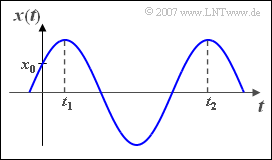Difference between revisions of "Aufgaben:Exercise 2.3Z: Oscillation Parameters"
From LNTwww
| Line 83: | Line 83: | ||
:$$X(f)={C}/{2}\cdot{\rm e}^{-{\rm j}\varphi}\cdot\delta(f-f_0)+{C}/{2}\cdot{\rm e}^{{\rm j}\varphi}\cdot\delta(f+f_0).$$ | :$$X(f)={C}/{2}\cdot{\rm e}^{-{\rm j}\varphi}\cdot\delta(f-f_0)+{C}/{2}\cdot{\rm e}^{{\rm j}\varphi}\cdot\delta(f+f_0).$$ | ||
| − | *The weight of the Dirac line at $f = f_0$ (first term) is ${C}/2 \cdot {\rm e}^{–\text{j}\varphi} = 3 \,\text{V} \cdot \cos(60^\circ)- 3 \,\text{V} \cdot \sin(60^\circ)\hspace{0.05cm}\approx \underline{1.5 \,\text{V} - \text{j} \cdot 2.6 \,\text{V}}$. | + | *The weight of the Dirac delta line at $f = f_0$ (first term) is ${C}/2 \cdot {\rm e}^{–\text{j}\varphi} = 3 \,\text{V} \cdot \cos(60^\circ)- 3 \,\text{V} \cdot \sin(60^\circ)\hspace{0.05cm}\approx \underline{1.5 \,\text{V} - \text{j} \cdot 2.6 \,\text{V}}$. |
{{ML-Fuß}} | {{ML-Fuß}} | ||
[[Category:Signal Representation: Exercises|^2.3 Harmonic Oscillation^]] | [[Category:Signal Representation: Exercises|^2.3 Harmonic Oscillation^]] | ||
Latest revision as of 14:14, 18 January 2023
Every harmonic oscillation can also be written in the form
- $$x(t)=C\cdot\cos\bigg(2\pi \cdot \frac{t-\tau}{T_0}\bigg).$$
The oscillation is thus completely determined by three parameters:
- the amplitude $C$,
- the period duration $T_0$,
- the shift $\tau$ with respect to a cosine signal.
A second form of representation is with the basic frequency $f_0$ and the phase $\varphi$:
- $$x(t)=C \cdot\cos(2\pi f_0t-\varphi).$$
From a harmonic oscillation it is now known that
- the first signal maximum occurs at $t_1 = 2 \,\text{ms}$,
- the second signal maximum occurs at $t_2 = 14 \,\text{ms}$,
- the value $x_0 ={x(t = 0)} = 3 \,\text{V}$.
Hint:
- This exercise belongs to the chapter Harmonic Oscillation.
Questions
Solution
(1) It is $T_0 = t_2 - t_1 = 12\, \text{ms}$ and $f_0 = 1/T_0 \hspace{0.15cm} \underline{\approx 83.33\, \text{Hz}}$.
(2) The shift is $\tau \hspace{0.1cm} \underline{= 2\, \text{ms}}$ and the phase is $\varphi = 2\pi \cdot \tau/T_0 = \pi/3$ corresponding to $\varphi =\hspace{0.15cm} \underline{60^{\circ}}$.
(3) From the value at timet $t = 0$ it follows for the amplitude ${C}$:
- $$x_0=x(t=0)=C\cdot\cos(-60\,^\circ)={C}/{2}=\rm 3\,V \hspace{0.3 cm} \Rightarrow \hspace{0.3 cm}\hspace{0.15cm}\underline{\it C=\rm 6\,V}.$$
(4) The corresponding spectral function is:
- $$X(f)={C}/{2}\cdot{\rm e}^{-{\rm j}\varphi}\cdot\delta(f-f_0)+{C}/{2}\cdot{\rm e}^{{\rm j}\varphi}\cdot\delta(f+f_0).$$
- The weight of the Dirac delta line at $f = f_0$ (first term) is ${C}/2 \cdot {\rm e}^{–\text{j}\varphi} = 3 \,\text{V} \cdot \cos(60^\circ)- 3 \,\text{V} \cdot \sin(60^\circ)\hspace{0.05cm}\approx \underline{1.5 \,\text{V} - \text{j} \cdot 2.6 \,\text{V}}$.
